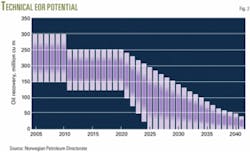Carbon dioxide injection currently is not a commercial alternative for enhancing oil recovery off Norway, according to an April 2005 Norwegian Petroleum Directorate (NPD) study.
The study found several impediments for injecting CO2, even though it determined that the technology was feasible and could substantially increase oil recovery.
The main impediments were the expense for building a network for delivering CO2 to the fields and the high estimated $30-33/bbl cost for oil recovery.
Norway recoveries
Fields off Norway already have high recovery factors because operators have implemented such technologies as early water and gas injection, wells with multiple horizontal branches, advanced seismic surveys, and effective reservoir visualization programs.
These high recovery factors mean that less oil remains to be produced with CO2 EOR.
NPD estimates that oil fields off Norway will have a 45.5% average recovery factor with some fields recovering more than 60% of the oil in place (Fig. 1).
The NPD CO2 study found 20 oil fields off Norway suitable for CO2 EOR. It said these fields could potentially recover 0.9-1.9 billion bbl of oil with CO2 injection if sufficiently large CO2 quantities become available and if economics allows for costly facility modifications that in some fields may require processing equipment for removing CO2 from sales gas. Also some fields would need new platforms and the drilling of CO2 injection wells.
The 30-year history of CO2 injection in the US and other countries indicates that this technology increases oil recovery by 7-15% as compared with waterflooding alone, but the study explained that the reservoir characteristics of fields outside Norway are different, making any direct application of this experience to fields off Norway difficult.
For instance, studies on the North Sea Gullfaks, Ekofisk, Brage, and Forties fields indicate much lower recovery factors with CO2 injection, primarily because of wider spaced wells than is typical for onshore CO2 EOR projects. The NPR study, therefore, assumed an incremental 3-7% increase in oil recovery with CO2 injection for fields off Norway.
Also, Fig. 2 shows the potential oil recoverable decreases if fields do not implement CO2 injection in the next few years.
CO2 sources
Potential CO2 sources include Norway’s planned gas power plants and Denmark’s existing coal power plants, but the study said that the technology for cost-effective capture of CO2 from gas power plants is still 5-6 years away and the CO2 from Denmark would require costly pipelines. As an alternative to pipelines, the NPD study also evaluated delivering CO2 with ships directly to oil fields as a long-term alternative.
Regarding capture of CO2 from gas-fired power plants, the study indicated that such CO2 separation technology as used in the Sleipner field has not been proven out on large gas and coal power plants with their lower exhaust pressures and CO2 concentrations. Also the estimated cost of capture technology varies widely.
The study estimated that fields off Norway would need about 500-750 million tonnes of CO2 to realize fully the potential of CO2 EOR. This is about 25 million tonnes/year of CO2 for 30 years with the years 2015-25 as the period needing the most CO2. Such CO2 sources off Norway as the Sleipner and Snøhvit fields are too small to provide this amount of CO2. Also these fields already have facilities to reinject CO2, so that moving this CO2 to other fields would not provide an environmental benefit, the study said.
The study also pointed out that CO2 EOR has the problem of requiring CO2 injection for only limited periods. This means that to avoid venting CO2 to the atmosphere from sources such as power plants, the injection infrastructure would need to store CO2 during times when CO2 was not needed for injection into a reservoir.
Potential projects
Of the potential CO2 EOR projects off Norway, the Gullfaks field was the most likely candidate, but in 2004 the Gullfaks licensees abandoned plans for injecting CO2 because of poor economics. For Gullfaks, the NPD CO2 study estimated that a CO2 project would require an initial $1.8-2.0 billion investment of which about $1.1 billion would be for CO2 capture and transport.
According to the NPD study, no licenses off Norway have concrete evaluations under way that could result in CO2 injection in the next 2-5 years, although some CO2 projects may start later. For instance, the study said, ConocoPhillips has several alternatives for increasing recovery from the Ekofisk field, including CO2 EOR, but if implemented, CO2 injection would not start until 10-15 years from now.
Also Norske Shell AS, Statoil ASA, and Norsk Hydro Produksjon AS have a study under way, with partial funding from the Research Council of Norway, on using CO2 from the planned gas power plant at Tjeldbergodden for CO2 injection and storage in the Draugen and Heidrun fields in the Norwegian Sea. NPD expected results of the study in about 2 years, although it estimated that CO2 injection in Draugen would not start until 2010, at the earliest.
NPD also added that CO2 injection also depends on whether the Tjeldbergodden gas power plant will include CO2 capture technology. ✦



